Lupine was quite recently a conventional agricultural plant, which was used in the production of decorative products, in paper production, in the manufacture of cosmetics, soap and medical plasters.
Also very often, this flowering plant can be found on wasteland and around abandoned houses in the form of weeds. However, for some long, Lupine loved the gardeners for his decorative properties. Today, you can often find bright and incredibly beautiful flower beds, completely covered with multi-colored lupines. Therefore, if you want to make your site unique and colorful, then this plant is exactly what you need. After all, the landing and care for Lupine in the open ground will not be much difficulty.
In this article, we will consider the features of Lupine, as well as tell about all the main and most popular types of this blooming plant. Let us describe all the nuances of agrotechnika growing in more detail.
Features and Description of Lupine
Lupine refers to the numerous family of legumes, is an annual, biennium and perennial, depending on the specific species. In appearance, it is sometimes possible to determine if Lupine is in front of you: the white narrow-on is most often the annual, and the blue is long-term.
South Africa and the Mediterranean countries are considered to be the birthplace of Lupine growing, this flower and in North America, Chile and Canada. It is here that Lupine is cultivated culture. In Nature, Lupine also occurs in nature, but it is inferior in his appearance to other representatives of this family. Most often it is a white flower of low growth.
Translated from Latin "Lupus" means "wolf", very often in ancient times, this flower was called "Wolf Bob". There are two versions of the origin of this name. According to the first, from Lupine did a special witchcraft infusion, which is able to turn a person in the forest predator of the wolf. According to another version, this name plant received because of its "wolf" endurance and strength, because Lupine is growing perfectly in any conditions.
For the first time, cultivated types of Lupine were delivered to Europe from America at the beginning of the 20th century, after which this flowering plant was widespread.
Lupine description:
- Lupine in nature can occur in the form of a perennial plant and annual. An annual Lupins can be found on the territory of Russia, although lately very often in garden sites can be found different types of perennial lupins.
- Grow in the form of grassy plants, shrubs and semi-stares.
- The root system of this plant is rod, which is capable of growing a few meters deep into. The roots of Lupine have a distinctive feature, there are nitrogen-fixing bacteria on their surface, which can absorb the nitrogen molecule from the air. This consists of a very important function of Lupine, thereby it enriches the soil around him.
- The stem of this blooming plant can be herbaceous and apparent, it all depends on the specific type and variety.
- The difference between the species consists in the form of branches. They can be fluttered and represented.
- Soots to varying degrees are covered with foliage, which in shape can be palphatic.
- The leaves of a saturated green color are attached to the stalk on long stiffs, arranged alternately.
- Lupine flowers are collected in inflorescence in the form of an upheld brush. On one inflorescence there is a large number of flowers that are stuntful, half-and-one and once.
- Lupine's top brushes can be different, depending on the species, sometimes reaches one meter.
- The colors of Lupine can be the most varied: white, yellow, blue, blue, purple, purple, pink, red and even two-color.
- Lupina seeds are presented in the form of beans, which are cracked and small grains are cracked after drying.
- To date, about 200 varieties of Lupine, many species of which were bred by the breeder of J. Russelli.
Popular types and varieties of Lupine
In nature, there are about 200 different species, but only 10 decorative garden is grown. It is customary to share all Lupins into two large groups: Mediterranean and American. Consider more these plants depending on the growth period - annual or perennial.
Annual Lupins
- Lupine narrowed.
It is a herbaceous flowering plant, which in height can reach 150 cm. The stem of this type of plant is a reprehension with a rare location of the leaves. Out of the form of the leaves, the finger-separated, slightly pubescent. On coloring can be different: white, pink, purple. Although in the people, this kind of lupine is called "blue".
- Lupine hybrid.
It is a grassy annual, which is in height reaches 1 meter. The stalks of this type of lupine are amerement smooth, the leaves are complex, in the form of lanceathoid. Inflorescences are the top brushes consisting of small flowers. In colors can be different: white, purple, blue, yellow, pink, there are two-color. The flowering of lupine hybrid begins in June and lasts to the coldests.
- Lupine yellow.
Annual plant with extensive stalks and elongated leaves, densely sank. The leaflets are located on the pair, are attached to the stalk on long stiffs. The inflorescence is represented by the top brushes, quite elongated. Color color yellow.
- Lupine dwarf.
This type of lupine is growing in the form of small compact bushes, it reaches 15-50 cm. It is highlighted in bright blue inflorescence with white spots. Flowering of dwarf lupine begins with June. A beautiful decorative appearance that can form a bright dense carpet from bushes.
- Lupine changed.
Annual shrub plant, which also applies to low. The height reaches 50-100 cm. Motherland of this type of Lupine is Peru. In our latitudes are grown precisely as an annual seasonal plant. Among the bright green foliage rises high inflorescence from gentle yellowish colors. The top petals have a lilac color, which over time changes to red. Blossom begins from the beginning of June and lasts about 2 months.
Perennial Lupins
- Lupine silver.
Mostly grows in the West on small elevations. Most often, this type of Lupine has several reprehensive stems, which are in height reach 15-60 cm. Leaves from silver lupine complex palpal. The stem and the lower part of the leaves are covered with silk vesicles. Inflorescences have a different color: from dark blue to white with reddish spots in the center.
- Lupine Brevel.
Motherland of this type of Lupine is California, Oregon. It is a dwarf view that consists of sprinkling stems and high inflorescences. On average, inflorescence can reach 15 cm, which consists of small colors of purple blue painting with white spots. Blooming Lupine Brevel begins in June and lasts until the end of August.
- Lupine Arctic.
This kind of lupine is common in Alaska, where it grows on the small slopes, along roads and in the fields. Is a low-growing plant that reaches a height of 40 cm. The leaves are palmate, complex, among which a large number of stems growing from the buds. All inflorescence rather large, made up of small flowers of dark blue shade or bright blue.
- Lupine treelike.
Perennial that can reach a height of 2 meters. Home to this type of habitat is considered North America. Stem erect, well-branched. Completely strewn with complex leaves grayish-green color. Inflorescences are white, purple or yellow in color. Varieties of this type are especially popular in Russia.
- Lupine multivalent.
This type of lupine has good winter hardiness and unpretentious, so widespread in Russia. Multivalent lupins grown even in the taiga areas in some localities included in the list of protected plants. The birthplace of growth is considered North America. This plant is a perennial and herbaceous. The stem is erect, smooth and thick, coated complex leaves. Flowered inflorescence apical brush-shaped, made up of small flowers of bright blue hue. It is one of the most common and popular species on our territory.
The main varieties of lupine multisheeted:
- Shlossfrau - lupine buds with pink shade.
- Edelknabe - Lupinus Polyphyllus with inflorescences carmine.
- Burg Fraulein - white inflorescences.
- Apricot - lupine flower orange hue.
- Princess Juliana - flowering plants with buds of two colors: pink and white.
- Rubinkening - plants with bright ruby-purple flowers.
Methods lupine breeding
Lupines reproduce in two ways: by seeds and vegetatively. Planting perennial and annual lupine is not difficult if the responsible approach to this process. Let's take a closer look at each of the ways of getting young flowering plants.
Reproduction lupine seeds for seedlings
The easiest way to sow the seeds of lupine seedlings to the spring to plant it in the open ground.
- The best time for sowing - the beginning of spring.
- It is necessary to prepare containers for planting soil mix and cover them, which consists of equal parts sand, peat, turf land.
- Soil mixture previously well loosened, so that it does not stagnate water.
- Lupine seeds are also recommended to mix with rascal tubers of old plants, which contain nitrogen intimidating bacteria. Thus, you are stimulated by their faster formation in new plants.
- Seeds are plugged by about 1.5 cm, watered and closed with a film.
- The first shoots will appear approximately 2 weeks.
- To get a friendly shoot, before sowing seeds, it is best to wet and wrap in gauze. Leave for a while until the seeds are tagged and then heated.
- With the appearance of 4-6 leaves, the seedlings are landing for lupins into open ground. This usually happens 20-30 days after sowing.
- It is not worth tightening with disembarkation, since young plants are easier to transplant - less risk of damage to the root system.
Sowing seeds in open ground
Lupine seeds can be sung right in open ground. It is possible to start this in April, after the snow. However, the landing ground must be prepared since autumn. Seeds are plunged by 1.5-2 cm. Blossoms such plants will be in a year in May.
It is best right in the soil to sung seeds under the winter, somewhere in late October. Top of crops are closed with peat. And in August of the same year you will get flowering plants.
Pencornia reproduction
If you want to get young plants of rare and unusual varieties, it must be remembered that with seed reproduction almost all parent characteristics will be lost. In this case, it is worth paying attention to a vegetative way of reproduction.
To get cuttings, bushes that have reached 3-4 years are used. It is for them that the side shoots from the outlets are formed. Bottles are harvested in spring and summer. In the spring time, root rosettes are used from the renewal kidneys, and in the summer - side shoots from the sinuses of the leaves.
- To cut the cuttings you need to take a sharp knife. Breaking the cuttings better after the flowering of plants.
- Cut is necessary renewal kidney along with the heel or part of the root neck.
- Next, the resulting cuttings are planted in a shaded place, preferably in sandy soil.
- After 20-30 days, the cuttings will be allowed root, after which they can be planted at a permanent place.
Preparation before landing Lupins
To obtain bright and magnificent flowering flower beds with lupines, it is necessary to carefully prepare. Be sure to pick a suitable place. Although Lupine is considered an unpretentious plant, but it is possible to get bright and beautiful flowers in a certain place. It is also important to prepare the ground for planting seedlings or seeds.
Choosing a place for landing Lupine
Lupins are very unpretentious and drought-resistant plants, so they can grow almost anywhere. However, to obtain a beautiful and decorative plant, it is best to choose a more sunny plot with a small shadow. In the shadow of Lupine can be pulled out in the stem to the damage of the collapse of the infloresception.
Also when choosing a place, be sure to think about the garden and floral composition you want to get. It is important to correctly pick up a lupine variety at the height of the stem to get a beautiful flower garden.
Soil preparation for landing
It is best to cook the soil in the fall. Lupins prefer to grow on weakly acidic or low-alkaline soil, they are also suitable for drifting and sampling soils. In the fall, carefully disappear selected. Add Dolomite flour to acidic soil, and in alkaline - peat. Also remember that Lupins are poorly growing on heavy soils and in lowlands. To prevent water stagnation at the roots of the plant, create a good layer of drainage.
When to plant Lupins
It is important to choose the right time for landing lupins.
- Sowing seeds is carried out in early March, if you are going to grow seedlings.
- Directly in the ground seeds are best soaring autumn. At the end of October. Although, as an option, you can begin seeding seed into the ground in April after the snow.
- Seedling is planted in open ground when the first strong leaves appear. The main thing, do not tighten. Young plants easier tolerate transplant.
The process of landing of lupins in open ground
With the onset of heat and in the presence of a ready-made grained seedlings, you can start landing the lupins on your site.
Planting process:
- When landing Lupine seeds to do it in April or October. Seeds are sown to a depth of 1.5-2 cm, the distance between the plants should be 30-50 cm, since adult lupins grow up. This plant will bloom next year in spring.
- For seedlings, as well as for seeds, the soil is prepared in advance. Fits a mixture of equal parts of sand, peat and turf.
- It is necessary to prepare landing wells for seedlings. In size, they must be a little more root system with an earthy room.
- On the bottom of the pits can be placed a layer of drainage, as Lupins do not endure strong soil moisturizing. Small stones can be used as a drainage.
- Seedlings are planted at a distance of 50 cm from each other and is well watering with water.
Lupine care features in open soil
This decorative plant is unpretentious, so Lupine many years of care does not require anything from you, and in the end it will delight you with beautiful bloom. In the first years, it is advisable to water Lupins, loosen the soil and remove weeds, periodically feed.
Watering
Lupines are drought-resistant plants, so watering for them is needed rare. You can more often water these plants in the spring time, during the period of active growth, as well as in dry days of summer. Select your watering mode for these plants, focus on complete soil drying. On average, it will be enough to water once every two weeks.
Loosening
In the first years, it is important to loosen the soil around the plants, as well as remove all weeds. After a few years, you will have to begin to guess the lupins, since with time the roots and the root cervix begin with the plants.
Podchar
Lupins are plants that practically do not need fake, as they themselves can fertilize the soil around themselves. In the first year, the plant does not need fertilizer. A year after landing, you can feed the lupins with mineral fertilizers, in particular superphosphate and chloride potassium.
Lupina trimming
During flowering, it is important to trim faded inflorescences, so you will prolong the life of the plant. Some species can start blossoming. 5-6-year-old lupine bushes need to be removed, since over time they weaken and lose their decorativeness.
Fighting diseases and pests
Lupins are resistant to the appearance of diseases and pests. However, with improper care, in particular, not compliance with the rules of irrigation, the plant may become ill.
From the pests of Lupine affects the sprout flies, the wave. You can deal with them by using special drugs - insecticides.
Of the fungal diseases, it is worth noting a gray rot, spotty and rust. These diseases can lead to the death of the plant. Therefore, it is necessary immediately when the first signs are discovered to begin treatment with special fungicides.
Using Lupine in Landscape Design
Lupins are ideal for the design of any garden and the naud. They look great in solitary landing, where you can use both alpine varieties and the mixture. Tall plants are perfectly suitable for creating a background on flower beds, lower lupins can be used to design garden tracks and borders.
Beautiful lupins look at the landings along the buildings or fence. They can be combined with other perennial plants.
Stock Foto Lupine in landscape design
The most vivid features of the use of lupine in the design of the site can be seen on the proposed photos.
The use of lupine for the design of flower
Single Lupina landing
Lupine in the garden composition
Lupine is a very bright and unusual flowering plant. And even though it can sometimes be found as a weed, the decorative value of this plant is difficult not to notice. Lupine will become an excellent decoration of the garden or flower beds that do not require high costs on your part.

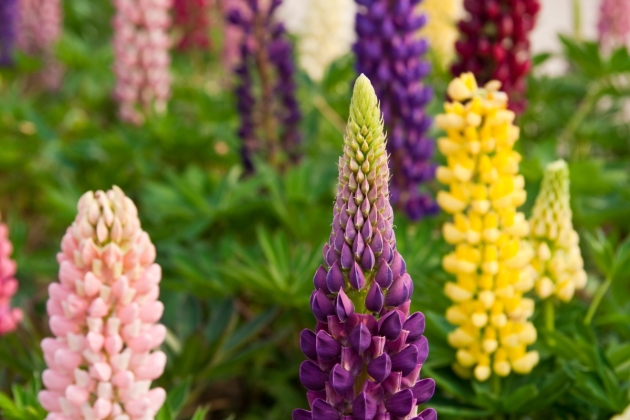
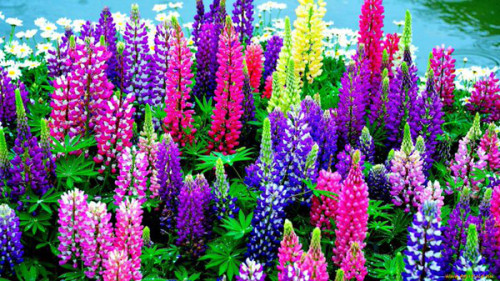

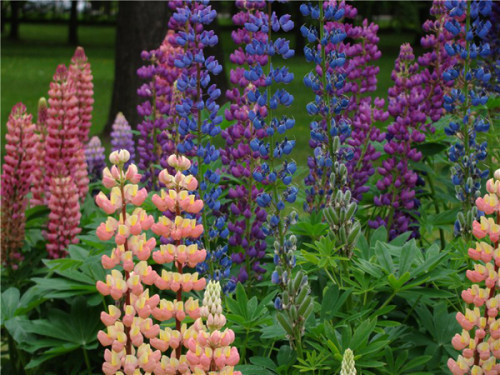
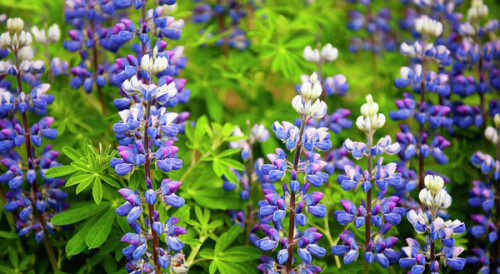
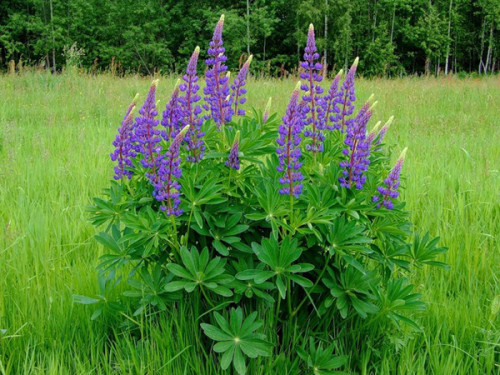
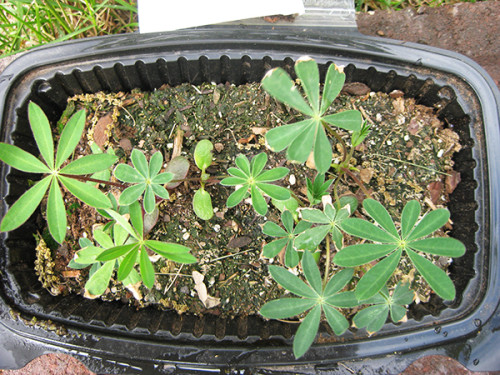

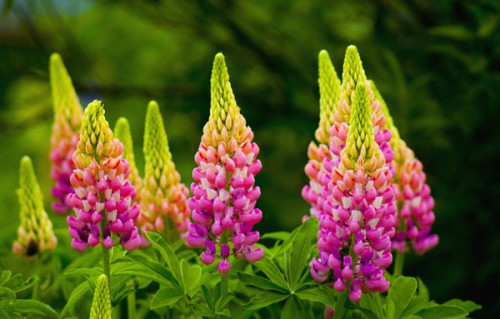
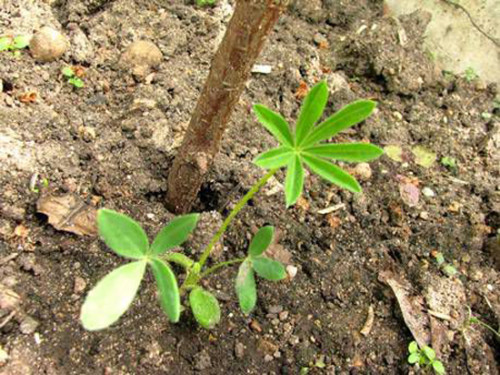

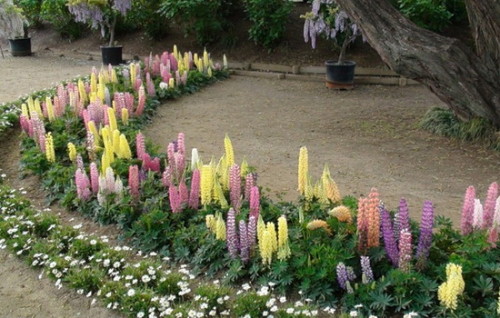

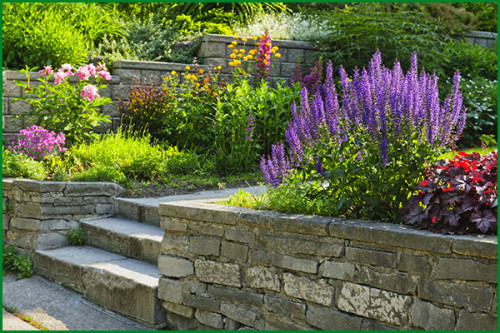












 Start a discussion ...
Start a discussion ...